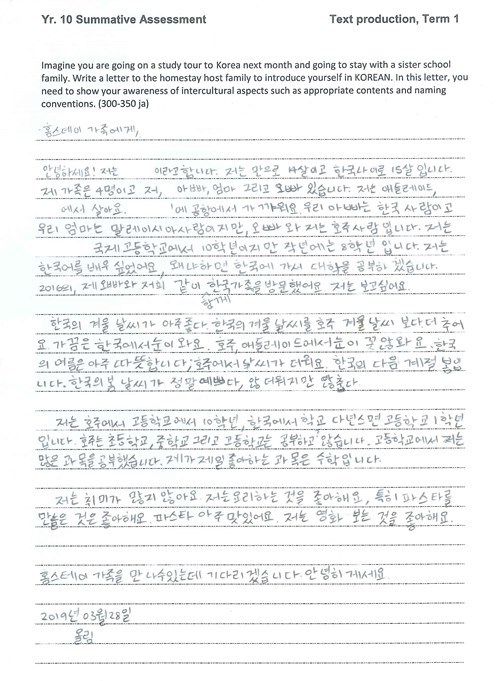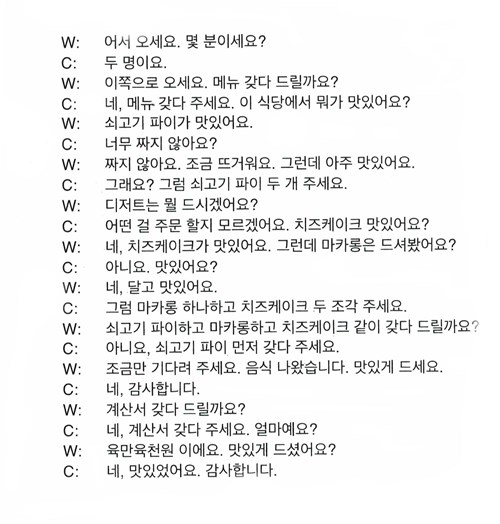Languages: Korean - Satisfactory - Years 9 and 10 (Year 7 entry)
Portfolio summary
This portfolio of student work shows that the student uses written and spoken Korean to interact with peers (WS3, WS5), teachers and other Korean speakers in face-to-face, local and virtual communications (WS1, WS2, WS4). The student exchanges information and opinions about personal and immediate interests and experiences and about broader topics of interest to young people (WS1, WS2, WS4) such as environmental issues, globalisation or technology. The student approximates pronunciation of polysyllabic words, making mostly appropriate changes in sounds on syllable boundaries (WS3, WS4). The student writes Hangeul following writing conventions (WS1, WS2). The student initiates conversations, and sustains interactions by asking and responding to each other and building on each other’s responses (WS3). The student uses appropriate facial expressions and gestures (WS3). The student expresses understanding, requests clarification, asks for opinions and provides their own opinions using reflective language as set phrases (WS3, WS4). The student asks for and makes suggestions (WS2). The student analyses and extracts information from different print, digital and multimodal sources, drawing on the context to help comprehension and using their knowledge of vocabulary, grammatical forms and structures relating to time, location, cases, honorifics, basic sentence types and text formats (WS5). The student creates and presents informative and imaginative texts in different formats and in different modes, expressing experiences and views for different purposes and audiences (WS1, WS2, WS3, WS4, WS5). The student uses a range of particles for various functions and modifies a noun using an adjectival form of a descriptive verb suffixed by –(으)ㄴ (WS2, WS3, WS4, WS5).The student uses some irregular verbs and verb phrases in complex structures as set phrases to express provision, prohibition, trial, and ideas or events relating to the future (WS2, WS3, WS4, WS5). The student expresses two ideas or events in different relationships using conjunctors such as –어/아서, –고, –(으)면 or –지만 as appropriate to connect clauses WS1, WS2, WS3, WS4, WS5). The student makes comparisons using –보다 더 … and expresses time duration using … 때/동안 (WS1, WS2, WS3). The student expresses the relative frequency of events using adverbs such as 가끔, 보통, 자주, 언제나 (WS4) and the relative locations of objects/people using location words in a formula: a noun + a location word + 에 (WS1). The student refers to self using either 나 or 저 appropriately according to the context (WS1). The student uses some basic conjunctive adverbs such as 그래서, 그런데, 그렇지만 and 하지만 to establish cohesion in texts (WS1, WS2, WS5). The student translates and creates simple bilingual texts across Korean and English, comparing different versions, identifying reasons for different interpretations and ways to retain and convey original meanings in translated texts. The student recounts their reactions to intercultural experiences and exemplifies how their personal experiences and assumptions influence their language use and perspectives (WS1).
The student explains how language use is adjusted to different purposes and audiences in different contexts and situations by providing examples from differing spoken and written forms of Korean (WS1). The student compares situations where it is or is not appropriate to use 반말 and other features of language such as text messaging or colloquial forms of expression in Korean, English or other known languages (WS1). The student describes how languages change over time and through contact with other languages and cultures by identifying possible examples of such change in Korean and other languages. The student relates grammatical elements in Korean such as case markers, particles, suffixes, and verb endings to their grammatical functions by explaining them using metalanguage (case, politeness, honorification, 반말, 높임말, native Korean/Sino-Korean). The student explains how cultural values and ideas are embedded in language use, including their own, and identifies how language reflects ways of thinking, views of the world and everyday cultural routines, drawing on examples from Korean, English and other languages (WS1).




